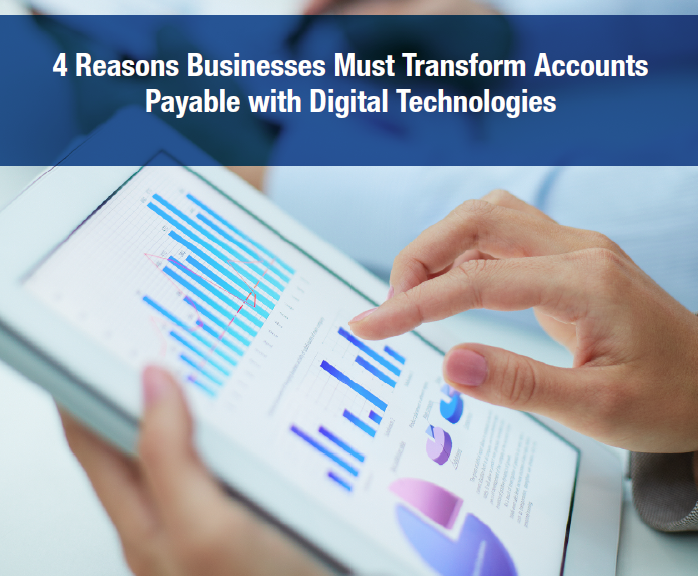
No matter what future you see ahead for your accounts payable (AP) organisation, one thing is sure: If your organisation is going to succeed in the emerging digital trade and commerce environment, it will need to process transactions more efficiently than ever, have faster access to AP information, and be able to act upon information and identify opportunities more quickly. This will require AP organisations to transform their processes with digital technologies. Accounts payable departments that delay
Accounts payable departments that delay their digital transformation initiatives risk falling behind their peers and putting
their business at a competitive disadvantage in the global business
landscape. This white paper details the growth of digital technologies, the dangers of relying on manual and semi-automated AP payable processes, the benefits of using digital technologies in AP, and how effective change management ensures the success of digital transformation efforts.
Digital Transformation
To compete in the emerging global economy, businesses must transform their corporate strategies to embrace digital. Indeed, digital transformation is a high priority in the boardroom. Eighty-five percent of businesses have an established digital transformation function as a focus for innovation, per Ernst & Young. Eighty-seven percent of businesses surveyed by Ernst & Young are explicitly considering digital transformation in their capital
allocation planning for the next two to three years.
Best-in-class organisations are already digitising their business processes.
The number one digital transformation strategy is to promote collaboration across the organization, as well as between multiple technologies, in support of business processes, Aberdeen Group reports. Organisations also are striving for greater flexibility in their business processes, more intelligent workflows, simplified and more efficient business processes, faster cycle times, and fewer paper-based business processes.
Some of the technologies organisations are using as part of their
transformation initiatives include:
• Automation
• Mobile and cloud computing
• Artificial intelligence
• Robotic process automation
• The Internet of Things
This transformation is evolving financial systems and processes.
Forty-eight percent of senior finance executives believe that digital
technologies will fundamentally change everything that finance does, a recent study from Accenture Strategy reported. CFOs are increasingly relying on digital technologies for security threat intelligence, blockchain, and artificial
intelligence. Buoyed by greater-than-expected returns from these digital investments, CFOs also are incorporating digital into their organisations at large to drive transformational change, Accenture Strategy reports.
Digital transformation is also on the AP department’s agenda. Most
payables departments are investing in process standardisation and
automation, per a recent IOFM study.
The Dangers of Manual Processing
Accounts payable earned a dubious trifecta in IOFM’s recent survey ofcontrollers: Payables topped the lists as the most time-consuming, laborious, and paper-intensive finance and administration function, ahead of activities such as accounts receivable (AR), payroll, tax, and audit and reporting.
In fact, AP received nearly twice as many votes from controllers as the most time- and labor-intensive finance and administration function than the next highest-ranked function.
Efforts to improve AP processes have historically been undermined by the double-whammy of high paper volumes and a lack of automation to facilitate timely payments and working capital optimisation. Most departments have been forced to rely on sub-optimal manual processes, reinforcing the longheld perception that AP is a tactical, back-office function.
Manually processing paper invoices results in:
• Costly and error-prone keying of invoice information
• Lost or misplaced invoices
• Long approval and exception resolution cycles (which result in late
fees and missed discounts)
• Compliance and security risks
• High paper storage and retrieval costs
• Delays uploading data on approved invoices to downstream systems
• Time-consuming supplier inquiries regarding invoice and
payment status
• Difficulty implementing operational best practices
The results of IOFM’s 2016 AP Key Performance Indicators Study illustrate the inefficiencies of manual invoice processing. Of the 69 full-time equivalents (FTEs) employed in AP departments (on average across all locations), all but one FTE performs invoice data-entry.
Manual processes also increase the chance of payment errors. Thirty nine percent of businesses report that duplicate payments and overpayments represent more than 1 percent of their payments. Worse, duplicate payments and over-payments account for 2 percent or more of all payments at 14 percent of the businesses surveyed for IOFM’s 2016 AP Key Performance Indicators Study. A rule of thumb is that a duplicate
payment rate over 0.5 percent indicates weak controls, or that the master vendor file needs a good weeding out, IOFM noted in its AP Department Benchmark and Analysis study.
Additionally, paper processes limit visibility into invoice information — a
top AP concern of 7 percent of businesses surveyed by IOFM. In a paper based environment, critical information is not captured, data is poorly organised, information is not timely, systems are not well-integrated, and decision-makers cannot access key variables. Moreover, it is hard for staff to track the status of invoices and other documents in a paper-based environment and to ensure that the appropriate individuals have approved documents in a timely manner. Paper invoices can sit for days on an individual’s desk, get stuck in inter-office mail awaiting approval, or become lost or misfiled.
Manual processes take significantly longer than their digital counterparts. Thirty-seven percent of organizations surveyed by Aberdeen Group point to the time it takes to complete financial processes, along with the demands they place on internal resources, as a leading pressure they face.
